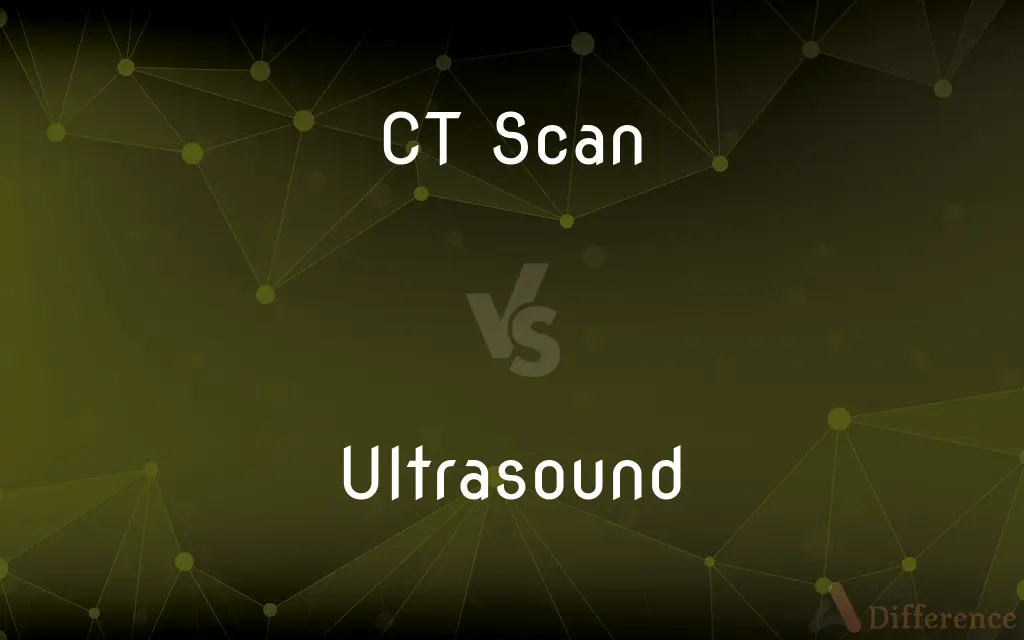CT Scan vs. Ultrasound — What's the Difference?
By Tayyaba Rehman — Published on January 8, 2024
A CT scan uses X-rays to create detailed cross-sectional images of the body, while an ultrasound uses high-frequency sound waves to produce images of internal organs.

Difference Between CT Scan and Ultrasound
Table of Contents
ADVERTISEMENT
Key Differences
CT (Computed Tomography) Scan is an imaging technique that uses X-rays and computer processing to create cross-sectional images of the body. Ultrasound, on the other hand, uses high-frequency sound waves to capture live images from inside the body.
A CT scan provides detailed images of bones, blood vessels, and soft tissues, making it ideal for diagnosing diseases and injuries. Ultrasound is commonly used for monitoring pregnancies and examining internal organs like the heart, liver, and kidneys.
CT scans involve exposure to a small amount of radiation, whereas ultrasound is radiation-free and considered safer, especially for pregnant women.
The procedure for a CT scan is typically quick and requires the patient to lie still inside a large machine. Ultrasound is often performed with a handheld device that glides over the skin with a conductive gel.
In terms of resolution, CT scans generally provide higher detail for internal structures, particularly for solid organs, bones, and tissues. Ultrasounds excel in visualizing soft tissues and fluid-filled structures.
ADVERTISEMENT
Comparison Chart
Imaging Technique
X-rays and computer processing
High-frequency sound waves
Common Uses
Diagnosing diseases, bone injuries
Pregnancy monitoring, organ examination
Radiation Exposure
Yes, involves minimal radiation
No radiation
Procedure
Patient lies inside a scanner
Handheld device used on the skin
Image Detail
High detail for internal structures
Better for soft tissues and fluid-filled areas
Compare with Definitions
CT Scan
An imaging method using X-rays.
The doctor ordered a CT scan to examine the patient's lungs.
Ultrasound
Uses sound waves for imaging.
The ultrasound showed the baby's heartbeat.
CT Scan
Involves lying in a large scanning machine.
During the CT scan, the patient remained still inside the scanner.
Ultrasound
Safe, non-invasive procedure.
The doctor performed an ultrasound to check the liver.
CT Scan
Provides detailed images of bones and tissues.
The CT scan was crucial for planning the surgical procedure.
Ultrasound
Handheld device applied to the skin.
The ultrasound technician moved the transducer across the abdomen.
CT Scan
Useful for diagnosing internal injuries.
The CT scan revealed a fracture that wasn't visible on X-rays.
Ultrasound
Commonly used in pregnancy.
Ultrasound images confirmed the due date of the pregnancy.
CT Scan
Produces cross-sectional images.
A CT scan provided detailed images of the brain.
Ultrasound
Effective for visualizing soft tissues.
An ultrasound was used to diagnose gallbladder issues.
Ultrasound
Ultrasonic sound.
Ultrasound
The use of ultrasonic waves for diagnostic or therapeutic purposes, specifically to image an internal body structure, monitor a developing fetus, or generate localized deep heat to the tissues.
Ultrasound
An image produced by ultrasound.
Ultrasound
(physics) Sound with a frequency greater than the upper limit of human hearing, which is approximately 20 kilohertz.
Ultrasound
(medicine) The use of ultrasonic waves for diagnostic or therapeutic purposes.
Ultrasound
(ambitransitive) To treat with ultrasound.
Ultrasound
Very high frequency sound; used in ultrasonography
Ultrasound
Using the reflections of high-frequency sound waves to construct an image of a body organ (a sonogram); commonly used to observe fetal growth or study bodily organs
Common Curiosities
When is a CT scan typically recommended?
For diagnosing bone injuries, internal organ damage, and certain diseases.
Is ultrasound safe during pregnancy?
Yes, it's safe and commonly used for monitoring fetal development.
Does a CT scan involve radiation?
Yes, it uses a minimal amount of X-rays.
Is a CT scan more detailed than an ultrasound?
Generally, CT scans provide more detailed images of bones and internal organs.
How does an ultrasound work?
It uses high-frequency sound waves to create images of the body's internal structures.
How long does a CT scan take?
Usually, it takes only a few minutes.
What are the common uses of ultrasound?
Monitoring pregnancies, examining organs, and diagnosing various conditions.
Can ultrasound detect cancers?
It can help in detecting and monitoring certain types of cancer.
What conditions can a CT scan detect?
It can detect tumors, fractures, infections, and more.
What is a CT scan?
A medical imaging technique that uses X-rays for detailed internal images.
How does the resolution of ultrasound images compare to CT scans?
Ultrasound is better for soft tissues, while CT scans excel in bone and organ imaging.
Can children safely undergo CT scans?
Yes, but with careful consideration due to radiation exposure.
Can ultrasounds be used for treatment purposes?
In some cases, they assist in treatments like biopsies or fluid drainage.
Is ultrasound effective for heart examinations?
Yes, echocardiograms are ultrasounds specifically for the heart.
What is the preparation for an ultrasound?
Often, little to no special preparation is needed.
Share Your Discovery

Previous Comparison
Pure Substance vs. Mixture
Next Comparison
GPS vs. GPRSAuthor Spotlight
Written by
Tayyaba RehmanTayyaba Rehman is a distinguished writer, currently serving as a primary contributor to askdifference.com. As a researcher in semantics and etymology, Tayyaba's passion for the complexity of languages and their distinctions has found a perfect home on the platform. Tayyaba delves into the intricacies of language, distinguishing between commonly confused words and phrases, thereby providing clarity for readers worldwide.













































